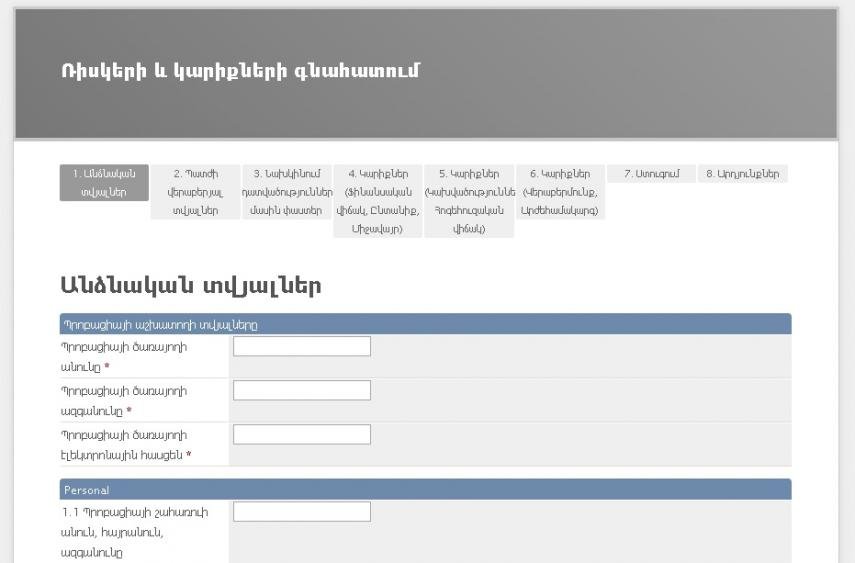NON-GOVERNMENTAL ORGANIZATION
Offender Risk and Needs Assessment: key element of the activity of Probation Service

Among the main goals of all criminal justice process and sanction system are prevention of recidivism and correction of the offender, in which we are ultimately interested for the same reason, i.e. prevention of the further unlawful behavior of the given offender and his/her law-abiding lifestyle.
In this context the Risk and Needs assessment process is designed specifically to address this goal: to prevent recidivism of a particular offender in question.
And this task is directly vested in the activities of State Probation Service of Armenia.
Couple words on the terminology.
The notion “Risk” typically estimates the likelihood that an offender will recidivate, based on his/her previous criminal history and facts from the biography than cannot be changed. Risk includes risk of reoffending and risk of harm.
The notion “Needs” answers to the question what factors that are conducive to recidivism are present in the case of an offender, however may still be corrected by a targeted intervention.
Thus, Risk and Needs assessment is used to answer two main questions:
How dangerous is the offender for the community (Level of Risk)?
What factors should be addressed to decrease his/her risk of reoffending in the future (Level of Needs to be addressed to reduce the overall risk of reoffending)?
All formal methods of assessing risk can be categorized as either the method of professional opinion or actuarial method.
Assessment by a professional opinion, the only method available in Armenia, is based on the point of view of judges, probation officers, who predict whether an offender will re-offend on the basis of their knowledge and practice. Such professionals may consider personality traits, mental illness, as well as biological, social and psychological factors that are in their view related to offending.
Actuarial methods require the collection of a large amount of statistical data which can indicate whether the offender is likely to re-offend. This method is reflected in special Risk and Needs Assessment tools, which help professionals from criminal justice field make an informed decision on the treatment of each particular offender which is supposed to be less subjective than the first option.
There are major benefits of such tools:
1.They are based on a number of predetermined factors that are proved to have an impact on reoffending rates according to numerous researches and statistical outcomes.
2.They help to identify the specific factors that must be tackled in relation to each particular offender.
3.The best Risk and Needs assessment tools predict possible re-offending on the basis of outcomes of the thousands of cases, i.e. more than any of the professionals would be able to handle in their entire career.
Despite the proven benefits of such tools we don’t have any of them in use in Armenia yet. This is why CSI has set up for itself an ambitious target – to develop such tool for Armenian reality.
However, this was a very challenging task because:
-the aggregated data needed to develop comprehensive Armenia-specific tool is absent;
-there is also very little research on the local specificities that must be taken into account while defining country specific factors;
This is why, while working on the tool and involving experts from various specialties, including psychologists, criminologists, specialists in processing of statistical data and lawyers as well as consulting opinion of professionals in the field of enforcement of punishment, it has become clear, that the additional main goal of the tool we develop is the possibility to collect and process data on offenders. The goal has become even more ambitious, to create a “self-developing” tool, which would increase its effectiveness in the local context with each use.
So let me introduce the first Armenian Risk and Needs Assessment tool, which also collects and systematize necessary data on offenders.
The tool consists from two major parts:
Assessment of static factors, like age, sex, previous criminal history and assessment of seven main groups of factors, which, according to international practice, impacts reoffending.
The second major part is assessment of needs, criminogenic in the frst place, which if tackled properly, should decrease risk level.
Information is collected from the following main sources: judgment, interview with probationer, information from police information center, home visit and interview with the family members, where necessary.
After the tool is filled out with the information it calculates the level of risk and exposes what factors must be addressed in the first place to reduce the overall level of risk of reoffending.
On the basis of the prediction made by the tool as well as on the basis of own expert opinion a Probation officer would be able to develop a sentence planning with relevant interventions, that would be tailored to the particular needs of the offender in question and help in deciding what kind of supervision is required.
And in general, the tool also stores the information for future analysis and correction of the formula used to calculate the risks and better predicting of the possible risks and criminogenic needs of offenders.

